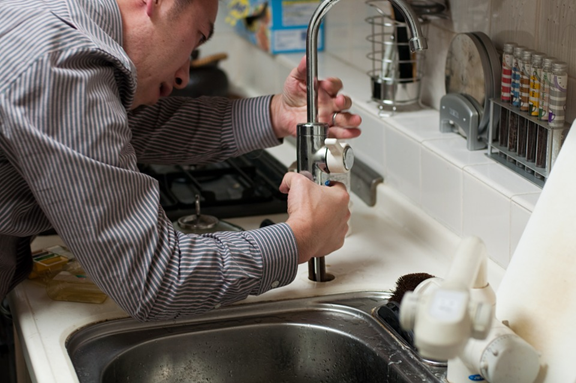Your bathroom gets a lot of footfalls and can be more susceptible to damage than other areas of the home due to the high volume it encounters.
Add in the moisture build-up from showers, baths, sinks, and more, and you can soon see your flooring take a bit of a battering that reduces its lifespan considerably.

One solution to help increase the lifespan as well as add a welcome touch of comfort is to invest in underfloor heating. This can be a fantastic upgrade to your bathroom, but you need to make sure it works for the bathroom you have.
In some cases, if you want the benefit, you may need to change your bathroom flooring altogether. Let’s take a look at why you should consider underfloor heating and what floor types it works best with.
Why Consider Underfloor Heating for Your Bathroom?
A bathroom can be a cold place any time of year, especially once you hop out of the shower or bath. An underfloor heating system can change this. With heat evenly distributed across the floor, your toes remain toasty as you go about your regular bathroom routines.
Not only does it keep you warm when you may have otherwise been cold, but it also helps minimize the moisture left in the air which prevents mold and mildew growth. Both of which can be damaging to health as well as the condition of the bathroom.
Factor in that you can remove radiators once underfloor heating is in place, you end up freeing up wall space that allows you to benefit from smoother lines, and a further opportunity to adorn the bathroom with furnishings of your preference.
Read Also:
What Floor Types Are Suitable for Underfloor Heating?
Underfloor heating can be used with a host of floor types with differing benefits between them. Some may cost considerably more than others, so it is worth factoring in budget as well as design.
Porcelain or Ceramic Tiles
Tiles can add a touch of class to a bathroom with the wide range of colors, patterns, and styles available. Durable and easy to clean, they can be a great flooring choice for any bathroom. Once you add underfloor heating, the benefit of porcelain or ceramic tiles becomes even more evident.
Tiles made from these are excellent heat conductors and allow an underfloor heating system to radiate warmth throughout the entire bathroom. With heat well retained, your floor can remain warm long after you have turned the underfloor heating off.
Engineered Wood
Engineered wood is designed to handle changes in temperature and humidity, making it compatible with underfloor heating systems. With the natural beauty of hardwood, your bathroom can take on a classic feel but have the modern benefits of underfloor heating and other bathroom tech.
With its construction meaning that the wood is stacked in opposing directions, users benefit from stability and a reduced risk of warping and expanding. Add in the moisture resistance that eclipses that of natural wood and you have a product that will look great and help you stay warm when you step into the cold.
Luxury Vinyl Tiling
Luxury Vinyl Tiling, or LVT as you may see it called, is a versatile flooring option that delivers on promises of durability, style, affordability, and low maintenance. Created to replicate wood, stone, or ceramic, an LVT bathroom floor can be used with any aesthetic in mind.
With excellent heat conduction, water-resistant properties, and durability, it is a great flooring type to deliver the benefits of an underfloor heating system. Its softer nature also means that underfoot, you aren’t just staying warm, you are staying comfortable too, something not all other floor types can offer.
Natural Stone
Natural stone certainly gives a visual appeal to a bathroom, but the choices are a little more limited. Not every stone will conduct heat well, so an investment in underfloor heating for a stone floor should be done with plenty of background research. Limestone or slate for example can work well with underfloor heating.
They conduct heat well and provide a stunning visual option to your bathroom. It could also be suggested that due to its harder nature, this flooring type may not be best in the bathroom if young children will be using it frequently.
Which Flooring Types Are Not Suitable for Bathroom Underfloor Heating?
Certain flooring types may look great in the bathroom but not deliver the heat conduction you would hope for. If underfloor heating is a consideration, these flooring types may be the ones you want to avoid.
Thick Carpet
Carpet is never the best idea for a bathroom, but should it be something you have in place, an investment in an underfloor heating system could be a waste of money. A thick carpet will act as an insulator, preventing the transfer of heat from being effective.
This means you could end up with random warm patches and some not even heated, or just a mild warmth that doesn’t fully justify the installation of the system.
Unsealed Wood
Wood flooring can look great but wood that isn’t sealed or engineered to handle temperature changes may warp, split, or shrink as the temperature varies. This can then lead to costly repairs and potential risks to those using the floor.
Granite
Some natural stones such as granite and some types of slate are not very good at conducting heat and could even crack due to the constant temperature changes.
Considerations Before Installing
Before committing to an underfloor heating system installation, you should consider a few things first. Look at the budget you are working with, consider the existing floor you have, and weigh up whether retrofitting a system causes unnecessary issues in the home.
You should include in this planning, how long the bathroom may be out of use for as well as the costs of running the underfloor heating system.









